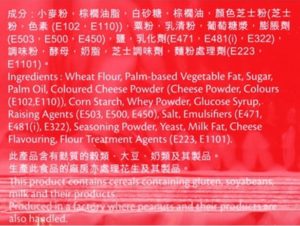Author: Agnes LEUNG
Assistant Professor, Department of Paediatrics, CUHK
Natasha’s law came into force in the UK after the girl’s tragic death, requiring all food premises to provide full ingredient lists with allergen labelling on every pre-packed for direct sale (PPDS) food made and sold on-site. Apart from that, food businesses must provide allergen information, either in writing or verbally, if any non-prepacked food they provide contains any of the 14 allergens listed on the food law. However, there are no such regulations in Hong Kong. It is crucial for food-allergic patients to play a proactive role in communicating with the restaurant staff about their food allergy and voicing their concerns about the hidden allergens when dining in or ordering a takeaway. They must bear in mind that cross-contamination can occur when the same surface, utensils or oil are used to prepare both allergen-free food and allergen-containing food. Sometimes, they may need to avoid certain types of high-risk restaurants, for example, buffets, Chinese seafood restaurants or Japanese sushi restaurants for seafood-allergic patients, or South-east Asian or Indian restaurants for peanut- or tree nut-allergic patients. Allergic reactions may still occur despite the restaurant staff being informed of a food allergy. Patients should carry their antihistamines and adrenaline autoinjectors at all times to prepare for any unpredictable exposure to food allergens.
For pre-packaged foods, it is mandatory under the Food and Drugs (Composition and Labelling) Regulations (Cap. 132) for the manufacturers to declare if the product contains any of the 8 most common food allergens in Hong Kong. These allergens include gluten-containing cereals (wheat, rye, barley, oats and spelt), milk, eggs, fish, crustacean shellfish, peanuts, tree nuts, and soybeans. Other less common allergens such as sesame and fruits (like kiwis and mangoes) are not covered by the Regulations, but they are usually shown in the ingredient list if added.
In most cases, the allergens are declared in the form of their common names (like wheat and milk) in the ingredients list, or in a separate statement of “This product contains….” next to the ingredients list (Figure 1). Some less common names may also be used along with parentheses highlighting the allergen, for instance, cheese, cream or whey (milk). It is important for food-allergic patients to be familiar with a list of ingredients that they need to avoid. Carrying an allergen card or list to grocery may help. Some allergen-free claims make it easier for the customer to understand which products are suitable for them. “Gluten-free” is generally considered as equivalent to “wheat-free”, and “vegan” means “milk-free” and “egg-free”.
People living with food allergy should make a habit of reading food label every time they purchase a pre-packaged food – even if they have bought it for thousands of times. It is because the manufacturers may change the ingredients anytime. Patients should never depend on the product name alone in guessing whether it contains an allergen – “sesame tangyuan” are often added with peanuts, and “soy sauce” generally contains wheat.
According to the Regulations, the allergen information on pre-packaged food can be printed in either Chinese or English language, or in bilingual form; while other languages like Japanese, Korean or Thai may be used solely for some imported food products. People who cannot understand these languages may sometimes find it frustrating when reading a monolingual food label. For people who are allergic to specific but not all types of fish, shellfish, or tree nuts, they may notice that listing out the specific type of these allergens is not mandatory. Some people may need to pay attention to some general terms including “natural flavouring” or “spices”, as these may cover certain allergens such as bonito extract (fish), mustard or sesame. Individuals, especially those with the risk of food-induced anaphylaxis, are often advised to ask the manufacturer, or not to buy the product, if unsure about the ingredients.
In some circumstances, precautionary allergen labelling (PAL) may be used. It is a voluntary warning statement, usually in the formats of “May contain traces of …”, “Produced in a factory where … is also handled”, or “Contains traces of ….”. It implies that the pre-packaged food is produced in the facility or on the production line shared with other products containing the specified allergens; in other words, there is a potential risk of the product being cross-contaminated.
Currently, there is no regulation on the use of PAL in Hong Kong. While the statements intend to facilitate safe and informed choice of pre-packaged food, they cannot reflect the actual risk level in most cases. A few countries including Australia and New Zealand have set a threshold allergen concentration for PALs, while others have not. Many food products with PALs were found to have no detectable amount of the allergens and thus do not impose a risk for most food-allergic individuals. On the other hand, missing of PALs does not mean that products are absolutely free from allergens. Misuse of PALs and the inconsistency in practice among different countries make it difficult to determine whether the product is safe for consumption. Food-allergic patients can only acknowledge the risk when consuming these products, and take precautionary measures such as having their medications ready around, or having their anaphylaxis action plan updated.

References:
- Oriel RC, Waqar O, Sharma HP, Casale TB, Wang J. Characteristics of Food Allergic Reactions in United States Restaurants. J Allergy Clin Immunol Pract. 2021;9(4):1675-1682. doi:10.1016/j.jaip.2020.12.018.
- What is Natasha’s Law – Natasha Allergy Research Foundation (https://www.narf.org.uk/natashaslaw)


